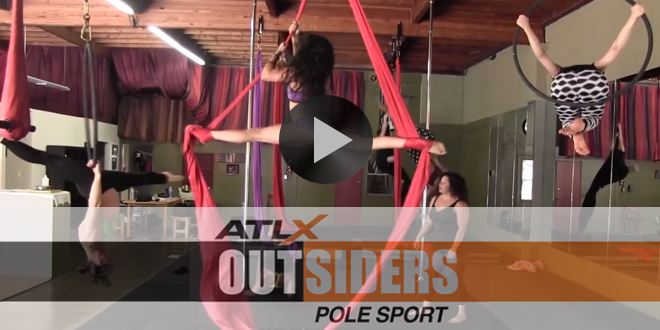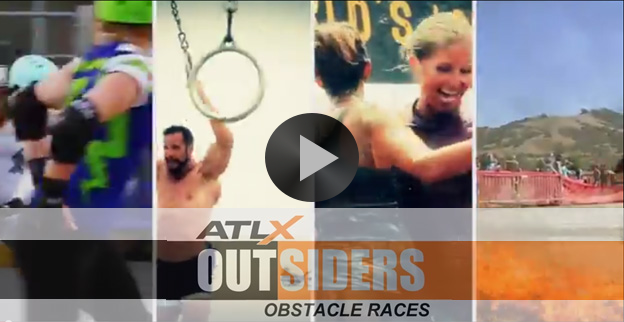By: Morgan Urtso
During my interview with Anthony Robles, the 2011 NCAA Division-I Wrestling National Champion born without his right leg, I asked him if he had heard of Chance Leonard, a man of incredible perseverance and athleticism.
Anthony’s response was a quick, “Yes! Chance wrestled at Oklahoma. He goes to my church now. He has an unbelievable story… he’s been through a lot.”
Anthony was right.
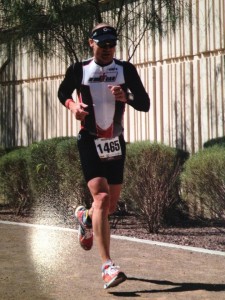
Chance Leonard just turned 45. Fifteen years ago, he underwent the first of four spinal surgeries, a total of 16 invasive hours that would span over a decade of time. Fifteen years before that, on a wrestling mat in Perry, Okla., he unknowingly sustained the spinal injury that would change his life forever. Two and half years ago, as he dove into the chilly water of Tempe Town Lake in the middle of a rainy Arizona windstorm, Chance Leonard became an Ironman.
Perry, Okla. is a small town known for two things: the construction equipment manufacturing company, Ditch Witch, and the 39-time State Champion Perry Maroons High School Wrestling Team. Chance Leonard grew up in Perry. He reminisced, “Growing up on a ranch, we were taught great work ethic. Then added to that was the sport of wrestling, and the discipline that came about by learning to be great at that sport.”
And he was great. An All-State wrestler in 1987, Chance’s name still graces the pages of the Perry Wrestling record books. The first sports goal he ever set for himself was to be a four-time State Champion, and he was right on track when he reached the regional tournament his freshman year.
He was 15.

Flipping his opponent onto the mat, his back arching too far under the weight, Chance’s spine was dealt its first blow. “It was the most agonizing sharp pain that I could possibly fathom at that point in time. I remember immediately falling to the mat and not being able to get up,” he recalled. His back and legs numbly tingling, Chance was carried to the locker room, terrified. “Of course at that point in time, I wouldn’t admit to too much crying, but there were a lot of tears. I couldn’t figure out why my body would not function.”
He never saw a physician. Never even got an X-Ray. As Chance continued to wrestle throughout high school and most of college at the University of Oklahoma, he experienced tremendous muscle spasms and pain daily. He assumed it was just one of those things every athlete faced. It would settle down after he was done wrestling. Right?
Wrong.
“Doctors weren’t picking up on what was taking place at the time,” Chance said.
Years later, while waterskiing at a lake outside of Columbia, Mo., the injury Chance’s body had kept moderately at bay awoke with a vengeance. Pain shooting down his legs and back, he was rushed to the ER, where a doctor uncovered spinal damage with roots dating all the way back to that wrestling mat in Perry, Okla. Chance was diagnosed with multiple ruptured discs in his back due to a spinal fracture incurred at the age of 15.
“So that was kinda nice, to know exactly what was going on and why I was in so much pain for the previous 15 years!” Chance joked.
Both feet had begun to go numb by the time Chance made his way into Dr. Robert Remondino’s office in Oklahoma City. “[Dr. Remondino] looked at me and said, ‘When is the last time you ate? Because we have to do this operation right now,’” Chance remembered.
 He went in for surgery the next day, Nov. 19, 1998, for a six-hour operation to repair a grade-3 forward-shifting spinal column slip to avoid irreversible damage, including the potential loss of feeling in his legs.
He went in for surgery the next day, Nov. 19, 1998, for a six-hour operation to repair a grade-3 forward-shifting spinal column slip to avoid irreversible damage, including the potential loss of feeling in his legs.
“After the surgery, I told myself, ‘This is a new beginning. I’m starting all over. I just have to take the first step,’” Chance said. He took that first step the day after Thanksgiving that year, just a few days post-op. One step became two, two became three, and that same day, Chance Leonard walked a mile.
But he didn’t get to walk too far before he reached his next obstacle: excruciating spinal headaches brought on by a Dural tear leaking cerebral spinal fluid. As the headaches worsened in severity and increased in length, Chance’s second spinal surgery became inevitable. He couldn’t even stand upright without fluid leaking through the tear, causing unbearable headaches.
His second surgical procedure, this time to close the Dural rupture, was scheduled for the end of January 1999 and lasted almost 2 hours.
Chance thought to himself after the anesthesia wore off, “I don’t want to go through any more of this pain. I don’t want to have any more setbacks. I just want to continue moving forward with my life.” His outlook began to change. “Tomorrow doesn’t exist anymore. All I’ve been given from God is today.”
Following his second round of spinal surgery, the major issues seemed to subside. Fighting through the daily pain, Chance was learning to start over. Learning to take those first steps. He moved to Dallas, where he met his wife, and together they began their family. In 2008, with their two children still quite young, the family moved to Scottsdale, Ariz.

With more than 300 days of sunlight every year, Arizonans are hard-pressed to find a good reason to stay indoors. Chance caught onto this very quickly, as Arizona introduced him to things like hiking, running, biking and swimming. He had stepped into the world of the triathlete, and he was fixated.
“One day in October, I told my wife, ‘I think I’ll go for a run today while the kids are taking a nap.’ And I remember her laughing at me. She was like, ‘Really? You’re gonna go for a run?’ And I said, ‘Yeah! I am! You don’t think I could go and run a couple miles?’ She goes, ‘When is the last time you actually ran any distance?’”
When was the last time he had run any substantial distance?
1991. Maybe 1992.
“So she said, ‘Yeah I don’t think you’re gonna be doing any kind of running anytime soon,’” and that was all Chance needed to hear. “Of course that ignited my competitive passion again. Instantaneously.” That day, Chance bet his wife a third child that he could run two miles in under 20 minutes.
He was back in 16.
Six days later, Chance ran a 5k in Denver. It took him 27 minutes. This took place less than a week after he ran two miles for the first time in 16 years and almost a decade after his second spinal surgery.
From there, Chance’s competitive fire began burning brighter and stronger than ever. He decided to run the PF Changs Half Marathon in January 2009. He completed it. He decided to do an Olympic Triathlon in March. He completed it.
By 2009, Chance had come a long way from living in uncertainty of his physical fate, but the ever-present pain served as a constant reminder of where he had been. “There’s not been a day in the last 30 years that I’ve not known a significant amount of pain,” Chance noted. “It’s always been, well, on a scale of one to 10, is it gonna be a three today or is it gonna be an eight today?”
 Chance’s next goal would be the Half-Ironman in October 2009. He trained daily, pushing through the pain, maintaining his focus and taking every step one at a time. “It wasn’t about recognition. It was about drive and human spirit and accomplishing a dream and a goal that we set for ourselves,” Chance explained of his motivation. He wanted to be an example of accomplishment. Of overcoming seemingly insurmountable obstacles, adding, “I think that’s when I started to really recognize that this was a blessing and not a curse.”
Chance’s next goal would be the Half-Ironman in October 2009. He trained daily, pushing through the pain, maintaining his focus and taking every step one at a time. “It wasn’t about recognition. It was about drive and human spirit and accomplishing a dream and a goal that we set for ourselves,” Chance explained of his motivation. He wanted to be an example of accomplishment. Of overcoming seemingly insurmountable obstacles, adding, “I think that’s when I started to really recognize that this was a blessing and not a curse.”
He would come to rely on that affirmation.
One week before the Half-Ironman in October, Chance approached yet another roadblock.
“It felt like a firecracker went off in my back,” Chance said.
“I remember feeling this tingling, sharp sensation down both of my legs. It was fire. It was hot.” Brushing it off as a tweak during a physical therapy session, he didn’t think much of it. Less than an hour later, Chance was overcome by a spinal headache “10-times worse” than those caused by the Dural tear leading up to his second spinal surgery back in 1999.
Despite advice from medical professionals who said re-tearing the Dural rupture was unheard of, Chance knew what had happened. The unbearable feeling was all too familiar. After consulting with Dr. Remondino in Oklahoma City, it was decided that Chance would get an MRI to confirm the tear. But only after he completed the Half-Ironman that Sunday.
Debilitating.
That’s the word Chance used to describe the pain
But the word alone doesn’t do his physical trauma any justice. Fighting through countless bouts of pain-inflicted vomiting and “head fog,” as he described it, Chance recounted his remarkable strength throughout that battle. “Only through God’s provision was I able to supernaturally overcome,” Chance said with confidence. He pressed on, holding tight to his faith.
“I did the race. Ironically, my body just put aside the pain, put aside the headaches, and I actually felt ok,” Chance remembered. “It was very rewarding to finish the race, to say the least. But I was not going to be deterred from completing my ultimate goal. Ironman Arizona.”
The post-race MRI confirmed the worst. Chance had re-torn the Dura. It was even worse than before, leaving a huge opening from where spinal fluid was leaking, causing an imbalance and excruciating headaches. Yet another surgery was the only option.
Chance’s third operation was scheduled for Jan. 15, 2010.
He had an apprehension with this surgery that he hadn’t felt prior to the first two, saying, “I kept thinking, well, the Dura isn’t very vascular, it doesn’t heal well [so] there’s potential for possible complications. What would happen if the patch didn’t hold? How long was it going to take? There are so many unknowns.” And although his doctor was extremely compassionate and understanding about his goals and how he would help Chance reach them, Chance felt anxious this time, remembering, “The worst thing about it is I have to start all over again. I have to start at the very beginning. Just one step, yet again.”
Chance’s reservations about this particular surgery were not unwarranted. A Dural tear cannot be measured before the surgeon goes in for the operation, so the length and difficulty of performing a patch are both unknown variables. Before the procedure, Dr. Remondino addressed this issue, saying he hoped the tear was about the size of the top of a pin, which meant it would take about an hour and a half to close. If it were a big tear, about the size of a pencil eraser, it would take longer, about two and a half to three hours. Bigger than that? The possibility was extremely unlikely.
Chance’s third surgery lasted nearly six hours.
“It was like the Grand Canyon of Dural tears,” Chance said.
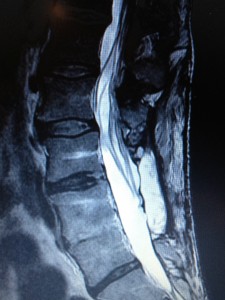 Dr. Remondino had never seen anything like it and had no idea how Chance was able to overcome the pain that was generated by it. When the doctor walked into the room the following day, he was carrying a stack of triathlete magazines. He said to Chance, who was lying flat on his back in the hospital bed, “I brought these for you; you’ll be here for a while.”
Dr. Remondino had never seen anything like it and had no idea how Chance was able to overcome the pain that was generated by it. When the doctor walked into the room the following day, he was carrying a stack of triathlete magazines. He said to Chance, who was lying flat on his back in the hospital bed, “I brought these for you; you’ll be here for a while.”
Chance laid flat on his back for six days straight. He lost almost 20 pounds. He wasn’t allowed to lift more than a jug of milk for the first month. He wasn’t cleared to walk until April 15.
“I still had this burning desire to overcome, and I knew at that point that all God had been laying on my heart one step at a time was coming to fruition,” Chance said. Attributing his will to keep going, his success, and his strength to his deep faith, he added, “That’s when the realization of my injury and surgeries became a gift. To be able to show others God’s grace and provision and transformational work in my heart, of who I was and what I was able to do.”
By the time he was cleared to walk again, he had about six and a half months to train for Ironman Arizona.
“I thought I was done having surgeries. Everything was going to be just fine now. I’ve finally got that injury closed. No big deal,” Chance remembered. So by the time Nov. 21, 2010 rolled around, Chance was ready to take on his ultimate challenge.
To calm his pre-race nerves, Chance recited scripture in his head. He recalled, “As I dove into the cold waters of Tempe Town Lake and swam out underneath the bridge, I just remember looking up and seeing thousands of people standing around… I had always wanted to hear Mike Reilly, the voice of the Ironman, say my name. I wanted to hear him say, ‘Chance Leonard, you are an Ironman as I finished the race.’”
The weather that day was elemental. With 20-30 mph wind gusts, rain, and even hail, the Ironmen were tested. For Chance, the 2.4-mile swim was relatively easy. Finishing it under his goal time, he continued to the 112-mile bicycle ride. There, he faced the most difficulty. Keeping his focus on finishing and enjoying the experience of his ultimate goal playing out before his eyes, he pushed through to the final stretch. The marathon.
 “I remember at the end of the race, there I was, crossing the finish line, and I don’t know how or why, but it seemed like there was nobody else there but me. And then I heard Mike Reilly say it…
“I remember at the end of the race, there I was, crossing the finish line, and I don’t know how or why, but it seemed like there was nobody else there but me. And then I heard Mike Reilly say it…
Congratulations, Chance Leonard.
YOU ARE AN IRONMAN.
The following week was Thanksgiving. Chance and his family spent the holiday in Oklahoma. Chance’s health was looking up after the Ironman, and he had plans to compete in a few races in the coming months.
Fast forward to March 2011.
Sitting in a meeting, Chance felt a debilitating pain in his neck. His fingers went numb almost instantaneously. He couldn’t even pick up a pen. He contacted his surgeon. “He was probably tired of hearing from me by then,” Chance joked.
Surgery number four was on the horizon.
Chance’s fourth and final spinal surgery was on his cervical spine, whereas the previous three were on his lumbar. After competing in the Marquee Triathlon on April 10, he flew to Oklahoma for surgery on April 15 to correct the ruptured discs in his upper spine. He received the same surgery as Peyton Manning about two weeks before the Broncos quarterback went under.
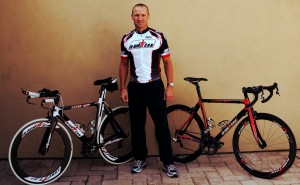 Present-day, Chance is preparing for a move to Oklahoma. His list of athletic objectives and pursuits is, of course, growing as usual. He plans on becoming a two-time Ironman by the end of 2014 and to compete in the U.S. Age Group Nationals. Ambitious. Ever since that first goal to become a four-time high school wrestling State Champion, that’s how he’s always been. Ambitious.
Present-day, Chance is preparing for a move to Oklahoma. His list of athletic objectives and pursuits is, of course, growing as usual. He plans on becoming a two-time Ironman by the end of 2014 and to compete in the U.S. Age Group Nationals. Ambitious. Ever since that first goal to become a four-time high school wrestling State Champion, that’s how he’s always been. Ambitious.
I pointed out to Chance that it seems as though, throughout the years, every time he was planning on racing or approaching yet another athletic milestone, a complication would arise in his spine and he’d require another surgical operation. But every time, he’d finish the race before addressing the medical issue. Before the MRI. Before going under the knife. Why? Why risk his health and potentially worsen the injury?
 ATLX The only sports entertainment television and digital media network fully devoted to everyday athletes, athletic lifestyle and athletic culture.
ATLX The only sports entertainment television and digital media network fully devoted to everyday athletes, athletic lifestyle and athletic culture.

